SUBFAMILY PONERINAE - Genus Plectroctena
| The Ants of
Africa SUBFAMILY PONERINAE - Genus Plectroctena |
|
| Contents - Ponerinae - PONERINAE Introduction |
In Tribe PONERINI. Plectroctena group
Diagnostic Features - Mandibles elongate, linear, weakly curved, with not more than two blunt teeth on the inner margin. Mandibular articulation associated with a marked excavation of the anterior margin of the head forward of the eye. Median portion of the clypeus reduced, vertical, with the frontal carinae almost overhanging the anterior margin of the head in dorsal view. Eyes small to minute. Promesonotal suture distinct, metanotal groove faint or absent. Middle and hind tibiae each with a single pectinate spur.
F Smith's (1858b) genus description is at ![]() . Arnold (1915: 84) had the genus
description as
. Arnold (1915: 84) had the genus
description as ![]() . Santschi (1924a)
reviewed the material then available and provided a key. He felt the
most significant defining character was the deep notch wherein the base
of the mandible fitted.
. Santschi (1924a)
reviewed the material then available and provided a key. He felt the
most significant defining character was the deep notch wherein the base
of the mandible fitted.
Revised by Bolton (1974b). Divided into two groups of species - the larger black P. mandibularis group and the smaller, depigmented P. subterranea group.
Bernard (1952) had this as strictly from the Ethiopian Region (sub-Saharan Africa), most in Congo and Gabon, from where 10 species had been described. Lamotte collected two males, both undescribed, having wings which were much more smoky than any known type. He felt it premature to assign them to new species as the males of most other species were unknown. The localities were Gba, on the road, a short male, close to Plectroctena punctua Santschi, but differing by the tint and ennervation of the wings, and the form of the medial segment. The other form came from Camp IV, 1000 m, a large male of 13 mm, which dubiously may have been of P. emeryi Santschi, known from Congo. Bolton (1974b) does not mention this report but the name punctua probably is a mispelling of punctatus Santschi (1924a), now regarded as a junior synonym of Plectroctena subterranea. P. emeryi (type location Zaïre) is a junior synonym of dentata, type location Angola (also known from Uganda; of which the male has not been described).
Lévieux (1983b) reported the feeding by genus members on millipedes and their eggs.
Bolton & Brown (2002) have added a few extra findings.
Key to African species (developed in part from Bolton, 1974b, Bolton & Brown, 2002):
| 1 |  Apical half of each mandibular blade swollen; basal tooth
absent; head relatively narrow, CI < 80; propodeal laminae
continuous around dorsum of declivity Apical half of each mandibular blade swollen; basal tooth
absent; head relatively narrow, CI < 80; propodeal laminae
continuous around dorsum of declivity |
2 |
| -- |  Apical half of each mandibular blade not swollen; basal
tooth usually present; head relatively broad, CI > 85; if
present, propodeal lamina confined to lateral portions of declivity
absent Apical half of each mandibular blade not swollen; basal
tooth usually present; head relatively broad, CI > 85; if
present, propodeal lamina confined to lateral portions of declivity
absent |
3 |
| 2 | 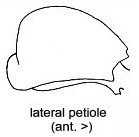 TL 10.9 mm; dorsal surfaces with numerous erect hairs;
eyes minute; petiole node long and low in profile TL 10.9 mm; dorsal surfaces with numerous erect hairs;
eyes minute; petiole node long and low in profile |
. |
| . |  |
Ghana - hastifera |
| -- | 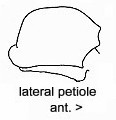 TL 7.4 mm; dorsal surfaces without erect hairs; no eyes;
petiole node relatively higher in profile TL 7.4 mm; dorsal surfaces without erect hairs; no eyes;
petiole node relatively higher in profile |
. |
| . |  |
Ghana - anops |
| 3 | First gastral tergite with an anterior transverse groove or impression which may run the width of the tergite or may be confined to the central 1/4 of the width | 4 |
| -- | First gastral tergite without a groove | 8 |
| 4 | Ventral surfaces of the head and sides of head below and behind the eyes with spaces between punctures finely striate; funicular segments 3-4 as long as, or longer than broad | 5 |
| -- | Ventral surfaces of the head and sides of head below and behind the eyes with spaces between punctures smooth and shining; funicular segments 3-4 broader than long | 6 |
| 5 | 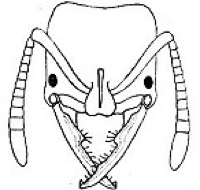 Very large, TL 21.6-23.2 mm; HL > 4.0; mandibles
relatively long, eye diameter 0.46 or more Very large, TL 21.6-23.2 mm; HL > 4.0; mandibles
relatively long, eye diameter 0.46 or more |
. |
| . |  |
Pan-African - cristata |
| -- |  Smaller,
TL 12.8-17.7 mm; HL < 4.0; relatively shorter mandibles; eye
diameter 0.46 or less Smaller,
TL 12.8-17.7 mm; HL < 4.0; relatively shorter mandibles; eye
diameter 0.46 or less |
. |
| . |  |
south and eastern Congo Basin - dentata |
| 6 | 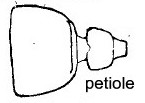 TL
15.6 mm; petiole in dorsal view relatively broad, node about as broad
as long TL
15.6 mm; petiole in dorsal view relatively broad, node about as broad
as long |
. |
| . | 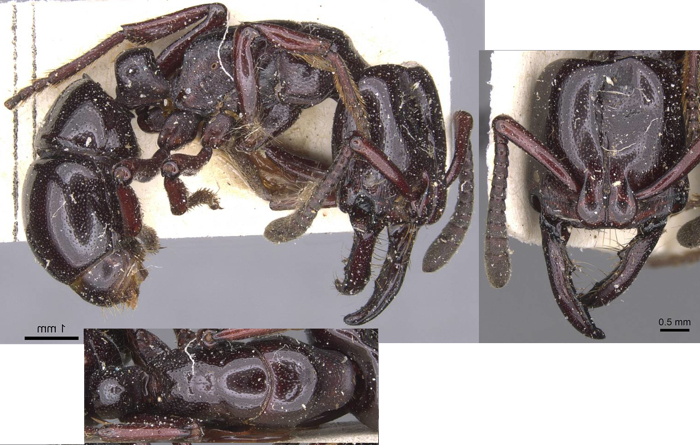 |
Congo Basin - latinodis |
| -- | Petiole in dorsal view relatively narrow, node distinctly longer than broad | 7 |
| 7 | TL 12.8-14.0 mm; eye smaller,
diameter <0.3; petiole in dorsal view usually without a median
impression in the posterior margin; full adult deep brown or red-brown (may be a junior synonym of minor) |
Congo Basin - gabonensis |
| -- |  TL 14.3-17.6 mm; eye larger, diameter >0.3; petiole in
dorsal view with a median impression in the posterior margin; full
adult colour black TL 14.3-17.6 mm; eye larger, diameter >0.3; petiole in
dorsal view with a median impression in the posterior margin; full
adult colour black |
. |
| . | 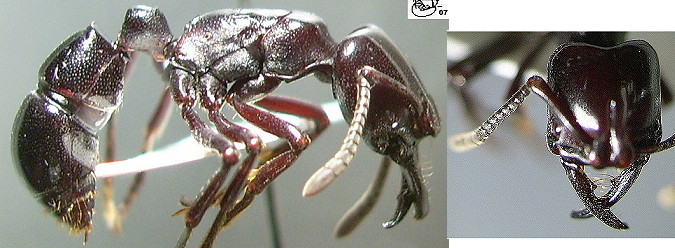 |
Congo Basin (east into Uganda) - minor |
| . | First gastral tergite without a groove | . |
| 8 | 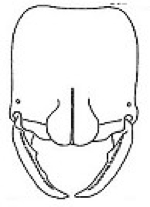 TL
5.7-6.1; head with very coarse dorsal sculpture of large pits or fovea,
which are broader than the distances separating them; mesonotum and
propodeum with a polished median longitudinal strip TL
5.7-6.1; head with very coarse dorsal sculpture of large pits or fovea,
which are broader than the distances separating them; mesonotum and
propodeum with a polished median longitudinal strip |
. |
| . |  |
West Africa - cryptica |
| -- | Head with only small punctures dorsally, these separated by more than their width; mesonotum and propodeum without a polished median longitudinal strip | 9 |
| 9 | 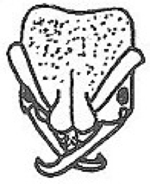 TL
9.5 mm; mandibles without teeth; node of petiole relatively long, low
and narrow TL
9.5 mm; mandibles without teeth; node of petiole relatively long, low
and narrow |
. |
| . |  |
West Africa - macgeei |
| -- | Mandibles with well developed basal tooth, petiole node relatively short, high and broad | 10 |
| 10 | 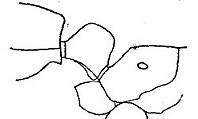 TL
14.5; dorsal surfaces of head and alitrunk with numerous erect hairs TL
14.5; dorsal surfaces of head and alitrunk with numerous erect hairs |
. |
| . |  |
Principé I. - gestroi |
| -- | Dorsal surfaces of head and alitrunk without erect hairs | 11 |
| 11 | Ventral surfaces of head without striation between punctures: relatively finely sculptured, quite shiny; reddish-brown | 12 |
| -- | Ventral surfaces of head with striation between punctures, at least anteriorly; quite coarsely sculptured, generally dull; black | 15 |
| 12 |  TL 13 mm; declivity of propodeum with a pair of basal
stout triangular teeth; black or black-brown TL 13 mm; declivity of propodeum with a pair of basal
stout triangular teeth; black or black-brown |
. |
| . | 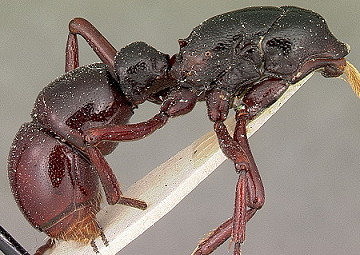 |
Tanzania - laevior |
| -- | Declivity of propodeum without teeth | 13 |
| 13 | 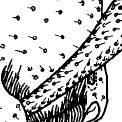 TL 5.5-7.7 mm; foveolae on dorsum of head and first
gastral tergite with a central appressed small hair; colour dark
red-brown to black TL 5.5-7.7 mm; foveolae on dorsum of head and first
gastral tergite with a central appressed small hair; colour dark
red-brown to black |
Ivory Coast - lygaria |
| . | 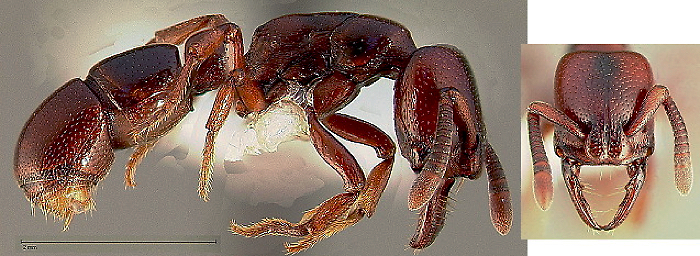 |
|
| -- | Foveolae on dorsum of head and first gastral tergite without a central small hair; HW smaller | 14 |
| 14 |  TL
7.6-10.8 mm; HW 1.4-1.96; basal tooth on mandible with anterior and
posterior surfaces of equal length; basal tooth linked to base of
mandible by a low shallow ridge; colour orange or red-brown TL
7.6-10.8 mm; HW 1.4-1.96; basal tooth on mandible with anterior and
posterior surfaces of equal length; basal tooth linked to base of
mandible by a low shallow ridge; colour orange or red-brown |
East Africa - subterranea |
| -- | 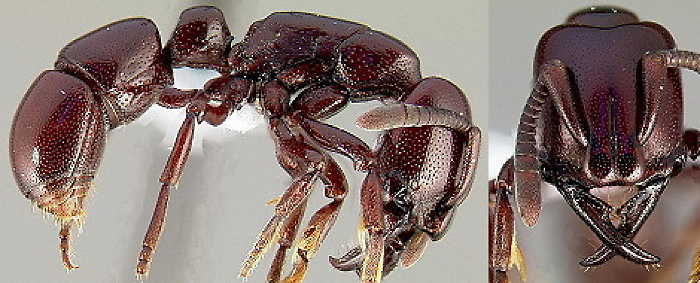 TL 8.5 mm; basal tooth on mandible without a defined
posterior surface; colour dark red TL 8.5 mm; basal tooth on mandible without a defined
posterior surface; colour dark red |
from Ivory Coast east to Uganda - ugandensis |
| -- | 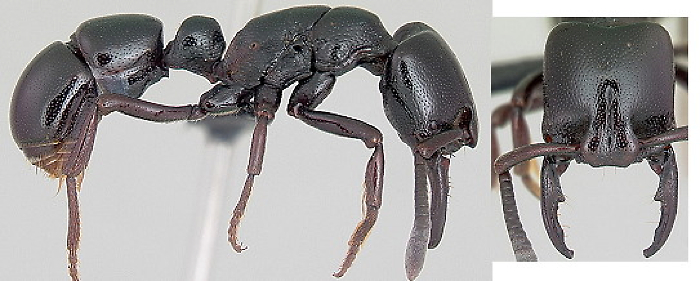 TL
7.5 mm; basal tooth on mandible without a defined posterior surface;
colour dark brown-black TL
7.5 mm; basal tooth on mandible without a defined posterior surface;
colour dark brown-black |
Cameroun - thaui |
| . | Ventral surfaces of head with striation between punctures, at least anteriorly; quite coarsely sculptured, generally dull; black | . |
| 15 |  TL
18.0 mm; anterior margin of scape with projecting erect hairs;
generally dull appearance TL
18.0 mm; anterior margin of scape with projecting erect hairs;
generally dull appearance |
. |
| . | 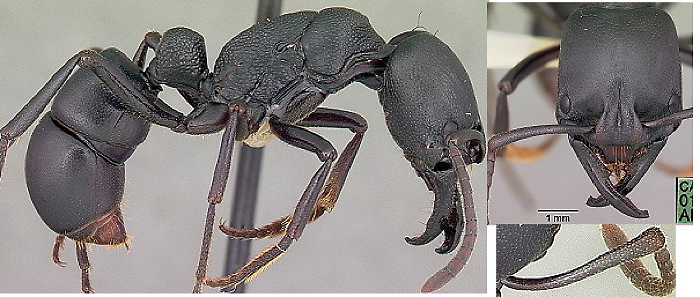 |
east & southern Africa - strigosa |
| -- | Anterior margin of scape without projecting erect hairs | 16 |
| 16 |  TL
15-5-24.1 mm; funiculus with segments 3-5 at least as long as broad; HL
> 3.0 TL
15-5-24.1 mm; funiculus with segments 3-5 at least as long as broad; HL
> 3.0 |
. |
| . | 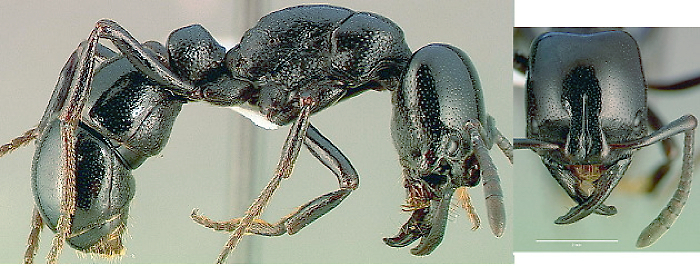 |
Panafrican - mandibularis |
| -- | 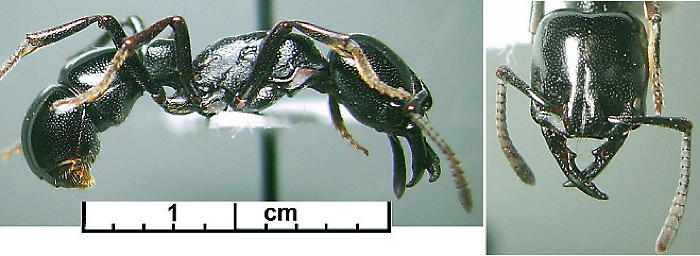 Smaller,
TL 11.5-13.0 mm, generally more slender; funiculus with segments 3-5
broader than long; HL < 3.0 Smaller,
TL 11.5-13.0 mm, generally more slender; funiculus with segments 3-5
broader than long; HL < 3.0 |
east & southern Africa - conjugata |
| PONERINAE Introduction |
© 2007, 2008, 2012, 2014 - Brian Taylor CBiol FSB FRES 11, Grazingfield, Wilford, Nottingham, NG11 7FN, U.K. |
href="plectroctena.htm"